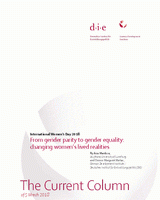International Women's Day 2018
From gender parity to gender equality: changing women’s lived realities
Manlosa, Aisa / Denise Margaret MatiasThe Current Column (2018)
Bonn: German Development Institute / Deutsches Institut für Entwicklungspolitik (DIE), The Current Column of 5 March 2018
Efforts to promote gender equality have come a long way in gaining attention and catalysing change, but there is still a long way to go. Women are now a part of the workforce, but the #MeToo campaign showed that the workplace can be a breeding ground of inequality and violence against women. This year’s International Women’s Day – celebrated on 8 March – carries the topic “Press for Progress”. In part, the theme is inspired by the World Economic Forum’s (WEF) Global Gender Gap Report in 2017, which indicated that – under current circumstances – gender parity in incomes may only be achieved in 217 years. This year’s International Women’s Day advocates for a “gender parity mindset.” But what is gender parity? What role does it play in promoting gender equality?
Gender parity is a statistical measure that provides a numerical value of female-to-male or girl-to-boy ratio for indicators such as income or education. For example, if there are equal number of girls and boys who completed primary education in a specific country, the gender parity ratio for that indicator is one. The greater the difference between girls and boys, the lower is the gender parity value. Gender parity is a useful tool for assessing gender inequality in specific areas, in setting goals, and in assessing change and progress under specific indicators of gender equality.
However, gender parity is not the same as gender equality and it is important to keep this difference in mind unless we mistake means for ends. One of the sub-indices in the WEF report concerns economic participation in 144 countries worldwide. This includes paid employment, whether formal or informal. Inevitably, the sub-index excludes unpaid work of women, which commonly supports economic activities in rural settings. However, unpaid work constitutes an important economic contribution, though it is not explicitly valued in monetary terms. It also has an implication on the extent to which women can participate in the economic activities they are interested in. If they are primarily responsible for unpaid work, they will hardly have as much time and energy to engage in economic activities as their male counterparts do.
Achieving gender equality is about making a real difference in women’s lives, particularly in labour contexts. It involves a substantive shift not only in the proportion of men and women under specific indicators, but in the deeper dimensions of societal norms and sense of identities – to be valued and respected equally, regardless of gender. If gender equality is to be realized, efforts need to go beyond achieving statistics for gender parity. In many parts of the world, there is still much room for progress in realising women’s access to basic human rights such as education, safe and secure employment, and to own property, among others. These aspects require supportive policies by governments, but work is needed to ensure that gender-sensitive policies are implemented and effective at enabling positive change in women’s lived realities. In southwest Ethiopia, for example, despite government policy providing formal recognition of women’s rights to land, customary practices of bequeathing land to sons are deeply entrenched. In many cases, women owned a piece of land to their name only after divorce or the death of a husband only to be dispossessed of land later on by male relatives. This happens despite a legal recognition of women’s rights. It takes more than a policy to make gender equality a reality.
“I believe that empowered women change society. The data tells (this to) us”, Melinda Gates said in Bill & Melinda Gates Foundation’s 2018 Annual Letter. She then posed a question “Why do working women get so much support in the Nordic countries?” that highlights the situation in other parts of the world, where even with laws in place, women do not get the support they need. In the Ethiopian example, the law required wives’ names to be included in the registration of land – a commendable step in the right direction. Yet the efficacy of laws is mediated by deeply entrenched ways of thinking and of being that shape people’s daily lived realities. Gender equality has several layers of complexity and we have just begun to scratch the surface. What does this complexity mean for policy-makers, researchers, development-practitioners, social workers, and anyone who is interested in promoting gender equality? Gender parity indicators will be useful for identifying problem areas that need attention. But when getting down to real change, it is important to look beyond the numbers and, paraphrasing UN Secretary-General António Guterres, look at the “facts on the ground.”

